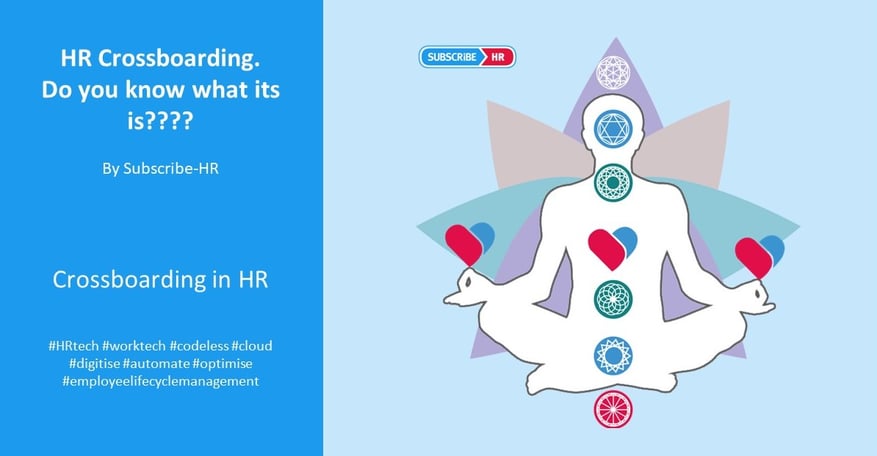As HR professionals we all constantly strive to improve the experience of welcoming new employees into the company. ✔️ But what about crossboarding? Yep, current employees who shift onto new roles need to be onboarded too!
With internal mobility programs becoming more and more common in the workplace, we all need to be thinking about crossboarding and helping employees transition to new roles.
Read on to find out everything you need to know about crossboarding, including ⬇️
- What crossboarding is
- The difference between crossboarding and onboarding
- The benefits of crossboarding
- Strategies to consider when implementing crossboarding
Let's dive right in! 🏊

Crossboarding: What is it Exactly?
Crossboarding entails the practice of relocating existing employees to new roles within the same organisation. The ultimate goal is to facilitate internal development and nurture talent.
When you help them leverage their existing skills and familiarity with the company culture, employees are able to more seamlessly transition into new roles. In fact, crossboarding has huge potential to reduce the need for external recruitment, as it taps into the existing talent pool within the company.
Crossboarding is especially useful in situations where you’re preparing employees for leadership or more specialised roles. That’s because by leveraging existing knowledge and networks, employees can navigate their roles effectively – you’ll be able to help reduce their learning curves so that they can adapt swiftly to new responsibilities.
👉 According to a study published Organization Science, internal hires perform significantly better than their external hire counterparts. Interesting, right?
Crossboarding is also an excellent tool for improving performance and retention rates. Companies who nurture interal talent find it easier to maintain a skilled and motivated workforce, leading to a positive impact on productivity and operational efficiency.
Additionally, since crossboarding reduces the need for external recruitment, it contributes to cost savings and a more streamlined hiring process. ✅

The Difference Between Crossboarding and Onboarding
Crossboarding and onboarding are similar – but completely different at the same time. Let’s find out why! ⬇️
Crossboarding
Crossboarding involves transitioning existing employees to new roles or departments within the same within the same organisation. It also 👇
- Focuses on helping employees adapt to different responsibilities, challenges, and expectations
- Aims to leverage internal talent and provide growth opportunities within the company
- Requires employees to build on their existing knowledge and skills while acquiring new ones
- Addresses the unique needs of employees who are already familiar with the organisation's culture and processes
- Focuses on aligning the employee's career path with organisational needs
Onboarding
On the other hand, onboarding refers to the process of integrating new hires into the organisation during their initial period. It also 👇
- Focuses on introducing new employees to the company's culture, processes, and work environment
- Aims to create a positive first impression and help new hires become productive quickly.
- Involves teaching basic company policies, procedures, and job responsibilities
- Addresses the needs of individuals who are entirely new to the company and its operations
- Focuses on making the transition into the company as seamless as possible for newcomers
The ultimate difference between crossboarding and onboarding
⛰️ Crossboarding is about moving current employees into different roles within the company to help them grow and develop. It's like giving them a chance to try something new while staying with the same team.
🚣 Onboarding, on the other hand, is for new people joining the company. It's about getting them familiar with how things work here and their specific job.

Why You Should Leverage Cross-boarding
To enhance employee retention and engagement
When you show your team that there's room for growth and new challenges right under your own roof, they're more likely to stick around. This means less turnover and a team that's more in it for the long haul.
Your current team knows the ins and outs of your company – its inner workings, its strengths, and its culture. When you move them into different roles, you're leveraging their valuable know-how. Plus, you get to keep their experience in-house.
Additionally, people often go job hunting when they're hungry for new horizons. Crossboarding satisfies that itch by giving your team fresh growth possibilities within your company. And that translates to fewer employees leaving and less money spent on hiring and training new faces.
To capitalise on your company’s culture
No awkward adjustment periods here! With crossboarding, your team doesn't need to get used to a whole new company. They can simply slide into their new role while feeling right at home.
Your team has probably built some great connections around the office. With crossboarding, those connections don't vanish – they get even stronger. Building on those existing relationships makes the transition smoother and collaboration a breeze.
To reduce external recruitment costs
Consider all the budget you spend on bringing in new faces from the outside. Crossboarding puts the brakes on those expenses by letting you shuffle your existing talent. Less recruitment fuss, less cash flying out the door.
New hires mean onboarding costs – getting them up to speed on policies, the company culture, and dozens of other things. But with crossboarding, your team members are already well acquainted with it all. They know the rules, so they can jump straight into the game.
To prepare employees for leadership or specialised roles
Crossboarding gives you the opportunity to nurture future leaders within your organisation. With crossboarding, you're not just spotting potential leaders – you're supplying them with the ideal environment for growth. This nurturing lays down a clear pathway for these talented employees to step into crucial roles with the kind of confidence and competence that can make a real difference. ⭐
Harnessing crossboarding for skill development also allows your employees to delve deeper into specific areas of expertise. This focused approach to learning can significantly enhance their capabilities within specialised domains, contributing to a more well-rounded and skilled workforce.
To demonstrate your investment in employee growth
Actions speak volumes. When you implement crossboarding, you're sending a powerful message about your dedication to employee growth. This commitment isn't just a pat on the back; it's real motivation for your employees to reach for higher levels of improvement.
When you embrace crossboarding, you're not only showing your employees that you value their progress, but you're also boosting your company's image as an employer of choice. And when you can show your organisation is committed to fostering growth from within, you become an even more appealing destination for top-notch professionals.
To create a strong culture of learning and skill development
Crossboarding facilitates constant growth by fostering a culture of learning and skill development. When employees see their peers expanding their capabilities and embracing new knowledge, it inspires them to do the same.
This approach not only encourages individual growth but also promotes a collective mindset of progress. You’ll be able to align your company with the contemporary view of career advancement, so learning will never stop – and that's a powerful attribute in the modern workplace.
To facilitate collaboration between HR and management
Crossboarding isn't a solo endeavor; it requires a harmonious collaboration between HR and management. This synergy begins by identifying the right candidates for crossboarding – those individuals who possess the potential and drive for new challenges.
HR then takes the reins, crafting tailor-made career paths for employees. As the transition unfolds, smooth coordination between HR and management is paramount. This joint effort ensures that the journey is seamless, providing necessary support and resources when needed.
To provide mentorship and training support
Mentorship and training lie at the heart of successful crossboarding. Paired with experienced mentors, crossboarded employees benefit from a wealth of knowledge and insights.
Simultaneously, specialised training programs are designed to bridge any skill gaps. This dual approach guarantees that employees step into their new roles confidently and competently, integrating seamlessly into their new environment.

What to Consider When Implementing Crossboarding
- Identify the right candidates for crossboarding
Embarking on a successful crossboarding journey starts with identifying the right candidates.
Carefully consider criteria such as their skills, potential, and how well they align with the requirements of their new role. Balancing an employee's aspirations with the needs of the organisation is key to a successful match.
- Customise career paths and development plans
Once the candidates are selected, it's time to tailor their career paths and development plans. Each individual's journey should be unique, addressing their specific strengths and growth areas.
👉 This personal touch ensures that they are equipped with the necessary skills and knowledge to excel in their new role.
- Provide adequate training and skill development
Crossboarding demands a strategic investment in training and skill development. Equip employees with the tools they need to thrive in their new positions. This not only boosts their confidence but also contributes to the overall success of the transition.
- Communicate effectively and prioritise transparency
Communication is the backbone of successful crossboarding. Ensure that employees are well-informed about the transition process, from start to finish. Transparent communication fosters trust and minimises uncertainties.

- Manage the change and facilitate the transition
Change can be daunting, but with the right management, it becomes an opportunity for growth. Facilitate a smooth transition by providing the necessary resources and guidance. A well-managed transition sets the stage for success!
- Aid the collaboration between teams and departments
Crossboarding often involves interactions across teams and departments. Foster collaboration by encouraging open communication and shared goals. This cross-functional approach enhances the employee's integration into their new role.
- Put in place mentorship and support systems
Mentorship plays a crucial role in the crossboarding process. Pair crossboarded employees with experienced mentors who can offer guidance and insights. Support systems ensure that employees feel confident and supported in their new roles.
- Monitor progress and encourage feedback
Continuous monitoring of progress is essential. Regular check-ins allow for adjustments if needed and provide a platform for employees to voice their concerns or feedback. This two-way communication ensures a healthy transition.
- Balance workloads and expectations
Finding the balance between existing responsibilities and new expectations is vital. Overburdening employees can lead to burnout, so make sure you are setting realistic expectations to ensure a smoother transition.
- Measure success then continuously evaluate
Define metrics for success and periodically evaluate the outcomes. This data-driven approach helps refine the crossboarding process and make necessary improvements for future transitions.
- Ensure continuous learning
Crossboarding is a learning journey. Encourage a culture of continuous learning by offering resources, training, and opportunities for personal and professional growth. This mindset contributes to the ongoing success of both employees and the organisation.

Final Thoughts
As we conclude this exploration of crossboarding's potential, it's clear that this approach empowers companies to harness their existing talent pool, reduce turnover, and cultivate a culture of continuous learning. ✨
The investment in crossboarding not only enhances employee retention and engagement but also strengthens the fabric of the organisation itself.
In a world where adaptability is paramount, crossboarding provides a bridge for employees to embrace fresh challenges while building upon their existing skills and familiarity with the company's values. It's a testament to the organisation's commitment to growth, both for its employees and for the business as a whole. 🤝

